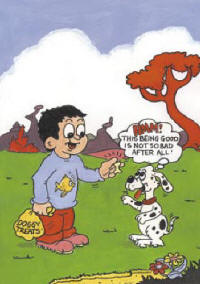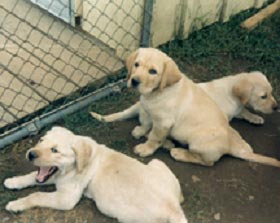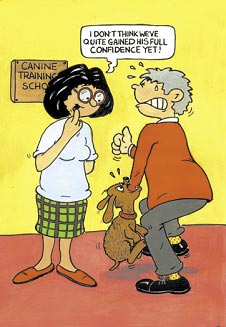At
what age can I start training
my new puppy?
You
will be training your puppy
from the moment you bring it
home and start to house train.
Puppies start learning from
birth. Good breeders encourage
handling and socialization from
birth. Some training can begin
as soon as the puppy can open
its eyes and walk. Young puppies
have short attention spans but
expect them to begin to learn
simple obedience commands such
as ‘sit', ‘down'
and ‘stay', from
as young as 7 to 8 weeks of
age. (Ask for our handouts on
'Rewards - learning and reinforcement',
'Puppy training – sit,
down, stand, and stay'; and
'Puppy training – come,
wait and follow' for training
on the specific tasks).
Formal
dog training has traditionally
been delayed until 6 months
of age. Actually this juvenile
stage is a very poor time to
start. The dog is beginning
to solidify adult behavioral
patterns, dominance behavior
is beginning to emerge, and
behaviors learned in puppyhood
may need to be changed. In addition
anything that has already been
learned or trained incorrectly
will need to be undone and retaught.
When
training is started at 7 to
8 weeks of age, use methods
that rely on positive reinforcement
and gentle teaching. Puppies
have short attention spans,
so training sessions should
be brief, but daily. Puppies
can be taught to ‘sit',
‘down', and ‘stand'
using a method called food-lure
training. We use food treats
to entice the dog to follow
its nose into the proper positions
for ‘sit', ‘down',
‘stand', and ‘stay'.
How
do I get started using food
lure training?
Small
pieces of food or a favored
toy can be used to motivate
your puppy to perform most tasks.
Provided the reward is sufficiently
appealing, the puppy can be
prompted to get the desired
response by showing the puppy
the reward, giving a command,
and moving it to get the desired
response. For example, food
held up over the puppy's
nose and moved slowly backwards
should get a ‘sit'
response; food drawn down to
the floor should get a ‘down'
response; food brought back
up should get a ‘stand'
response; food held out at a
distance should get a ‘come'
response; and food held at your
thigh as you walk should get
the puppy to ‘hee'l
or ‘follow'. By
pairing a command phrase or
word with each action, and giving
the reward for each appropriate
response, the puppy should soon
learn the meaning of each command.
The use of rewards and the specific
training commands are covered
in separate handouts on Rewards
– learning and reinforcement
for dogs and cats; Controlling
stealing and teaching the "give"
command; Teaching – sit,
down, stand and stay; and Training
puppies – come, wait and
follow.
How
often should I give the command?
Ideally
you should give the command
phrase once and then use your
food to move the puppy into
positions. Once the puppy has
performed the task, add in verbal
praise and an affectionate pat,
which are known as secondary
reinforcers (see below). Some
trainers also use clickers as
secondary reinforcers. If the
puppy does not immediately obey
on the first command, then you
are likely proceeding a little
too quickly. If you keep repeating
the command, the puppy will
learn that several repetitions
are acceptable before it needs
to obey. Keeping a leash attached
can help to gain an immediate
response if the puppy does not
obey.
Remember
that early in training your
puppy does not know the meaning
of the word. Therefore you could
just as easily teach your puppy
to sit with the word bananas,
(or sit in any other language)
as you could with the word sit.
The key is to associate the
word, in this case "sit",
with the action of placing the
hind end on the floor.
How
should I phase out the lure
and food rewards?At
first you are going to let the
puppy see the food in your hand
so that you will have her attention
and can use it to guide her
into position. As your puppy
begins to comply more readily,
you can start to hide the food
in your hand, but give the command
and repeat the motion or signal
that she has  learned
to follow. Soon the puppy will
come to expect the treat each
time she performs the task.
Then, signal and give the command,
but when she performs the task,
reward only with praise and
give the puppy an affectionate
pat. Next, you can begin to
vary the frequency, giving praise
with ;'good dog'
and perhaps patting each time,
but giving the food randomly,
perhaps every 3 or 4 times.
In time, the puppy should respond
to either the hand signal or
the command learned
to follow. Soon the puppy will
come to expect the treat each
time she performs the task.
Then, signal and give the command,
but when she performs the task,
reward only with praise and
give the puppy an affectionate
pat. Next, you can begin to
vary the frequency, giving praise
with ;'good dog'
and perhaps patting each time,
but giving the food randomly,
perhaps every 3 or 4 times.
In time, the puppy should respond
to either the hand signal or
the command
Over
time, the words "good
dog" or the affectionate
pat become secondary reinforcers.
Because they have been paired
with food in the past, they
take on more meaning and become
a reinforcement in themselves.
It is important to use secondary
reinforcement because you will
not always have food with you
when you need your pet to obey.
In addition, if you rely on
food to always get your puppy
to comply, you will have a puppy
that will only do the task when
you have a treat.
At
first training may begin in
designated sessions throughout
the day, with a variety of family
members. All rewards should
be saved for these training
sessions. Over time however,
you should begin to ask your
puppy to perform the tasks at
other times.
How
much time should I spend training
my puppy every day?
You
do not necessarily need to train
in a set session daily. Rather,
integrate these tasks throughout
the day. A goal to strive for
is at least 15 minutes of training
every day. These can be short
5 minute sessions spread throughout
the day. Try to have all family
members ask your puppy to do
these tasks. Remember to try
and train in every room of your
house. You want your puppy to
‘sit', ‘lie
down' and ‘stay'
everywhere, not just in the
training location.
Use
these training tasks as you
integrate the puppy into your
life. For example, ask your
puppy to ‘sit' prior
to receiving her food, ‘sit'
before you let her in or out
the door, and ‘sit'
before you pet her. These are
times when your puppy wants
something and is more likely
to comply. In this way you are
training your dog all the time,
throughout the day and also
establishing yourself as the
leader, the one who controls
the resources. Training your
puppy prior to getting each
reward also helps to prevent
problems. Having your puppy
sit before getting a food or
treat prevents begging, while
teaching your dog to sit before
opening the door can prevent
jumping up or running out the
door. Be creative. The time
you spend training your puppy
now will pay off when you have
an adult dog. To have a well-trained
dog, you need to be committed
to reinforcing the training
tasks on nearly a daily basis
for the first year of your puppy's
life. The more you teach and
supervise your puppy, the less
opportunity it will have to
engage in improper behaviors.
Dogs do not train themselves,
when left to choose their behavior
they will act like dogs.
What
can be done if my puppy is too
distracted or excitable to control?
Training
should begin in a quiet environment
with few distractions. The reward
chosen should be highly motivating
so that the puppy is focused
entirely on the trainer and
the reward. Although a small
food treat generally works best,
a favorite toy or a special
dog treat might be more appealing.
It might also be helpful to
train the puppy just before
a scheduled mealtime when it
is at its hungriest. For difficult
puppies or headstrong puppies
the best way to ensure that
the puppy will perform the desired
behavior and respond appropriately
to the command is to leave a
leash attached and to use a
head collar for additional control.
In this way, the puppy can be
prompted into the correct response
if it does not immediately obey
and pressure released as soon
as the desired response is achieved.
(see our handout on 'Management
devices in dog training') Clicker
training is also an excellent
way to immediately and strongly
reinforce the desired response.
(See our handout on ‘Rewards
– learning and reinforcement').
 Should
I also consider training classes? Should
I also consider training classes?
Pet
owners who are novices at training
can begin a training program
with these few simple steps.
It takes repetition, time and
perseverance for the puppy to
be able to predictably and reliably
respond to commands in a variety
of situations. The training
class serves many functions.
Of course trainers can demonstrate
techniques and help guide you
through the steps in training.
They can help advise you on
puppy training problems, and
can help you advance your training
to more difficult exercises.
The puppy will be learning in
a group situation, with some
real life distractions. And,
considering human nature, the
pet owner who takes his or her
dog to a puppy class, will be
forced to practice (do their
homework) throughout the week,
if they do not want to fall
behind by the next class. A
training class is a good place
to meet and talk to other new
puppy owners and see how all
puppies behave.
Training
classes for young puppies are
also an excellent way to socialize
your new puppy to a variety
of people, other dogs, and stimuli,
in a controlled environment.
In addition, you will learn
how to prevent problems before
they can begin, or deal with
them as they emerge, rather
than having to find a way to
correct problems that have already
developed. Your puppy might
also make some new friends of
the same age. You could then
visit these friends (or vice
versa) with your puppy for social
play and exercise sessions.
Since the primary socialization
period for dogs ends by 3 months
of age, puppy socialization
classes are most valuable for
puppies 8 weeks of age and older.
If all puppies in the class
have had initial vaccinations,
are healthy and parasite free,
the health risks are low and
the potential benefits are enormous.
Discuss when to start and the
location of classes in your
area with your veterinarian.
This client
information sheet is based on
material written by Debra Horwitz,
DVM, DACVB and
Gary Landsberg, DVM, DACVB.
© Copyright 2002 Lifelearn
Inc. Used with permission under
license. March 11, 2004.
|